The Sales Analysis of Tourism Industry in the Middle East is estimated to be valued at USD 289.7 billion in 2025 and is projected to reach USD 465.0 billion by 2035, registering a compound annual growth rate (CAGR) of 4.8% over the forecast period.
The tourism industry in the Middle East is experiencing significant growth, driven by increasing disposable incomes, expanding infrastructure, and government initiatives to boost travel and leisure activities. The market is being shaped by rising demand for both domestic and international travel, with consumers seeking convenience, personalized experiences, and seamless booking options. Technological advancements in the tourism sector have facilitated easier access to travel information, pricing comparisons, and digital payment systems, which enhance the overall customer experience.
Moreover, evolving lifestyle preferences, a growing focus on experiential travel, and increasing awareness of regional cultural and entertainment offerings are contributing to market expansion. Strategic investments in hospitality, transportation, and tourism promotion are further supporting market growth.
The combination of favorable economic conditions, targeted marketing campaigns, and advancements in digital platforms is expected to drive sustained demand As travel preferences continue to evolve, the Middle East tourism market is anticipated to see continued expansion across various booking channels, consumer segments, and age groups, creating opportunities for tailored services and improved customer engagement.
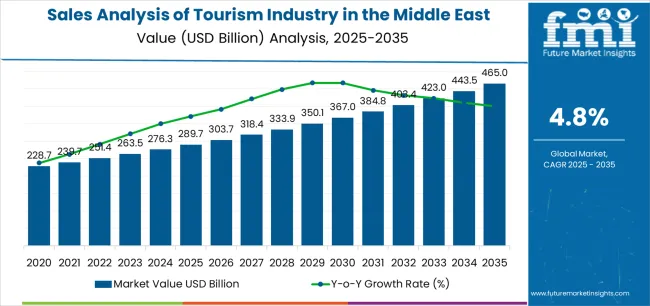
| Metric | Value |
|---|---|
| Sales Analysis of Tourism Industry in the Middle East Estimated Value in (2025 E) | USD 289.7 billion |
| Sales Analysis of Tourism Industry in the Middle East Forecast Value in (2035 F) | USD 465.0 billion |
| Forecast CAGR (2025 to 2035) | 4.8% |
The market is segmented by Booking Channel, Consumer Orientation, Age Group, Tour Type, and Tourist Type and region. By Booking Channel, the market is divided into Online Booking, Phone Booking, and In-Person Booking. In terms of Consumer Orientation, the market is classified into Women, Men, and Children. Based on Age Group, the market is segmented into 26 To 35 Years, 15 To 25 Years, 36 To 45 Years, 46 To 55 Years, 56 To 65 Years, and 66 To 75 Years. By Tour Type, the market is divided into Package Traveler, Independent Traveler, and Tour Group. By Tourist Type, the market is segmented into International and Domestic. Regionally, the market is classified into North America, Latin America, Western Europe, Eastern Europe, Balkan & Baltic Countries, Russia & Belarus, Central Asia, East Asia, South Asia & Pacific, and the Middle East & Africa.
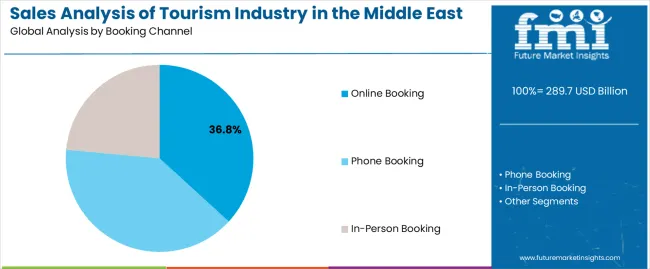
The online booking channel is projected to hold 36.80% of the tourism market revenue share in the Middle East in 2025, making it the leading booking method. This growth is driven by the convenience and accessibility offered by digital platforms, allowing travelers to plan, compare, and confirm bookings efficiently from anywhere. The proliferation of smartphones and high-speed internet has accelerated the adoption of online booking platforms, supporting real-time availability, flexible payment options, and instant confirmations.
Furthermore, online booking platforms provide consumers with tailored recommendations, dynamic pricing, and loyalty rewards, enhancing user engagement and satisfaction. The integration of advanced software for travel management and analytics has improved the efficiency of online channels, further boosting adoption.
Consumer trust in secure online transactions and the ability to access reviews and ratings also contribute to the segment’s dominance These factors collectively reinforce online booking as the preferred method for travelers, driving its significant share in the Middle East tourism market.
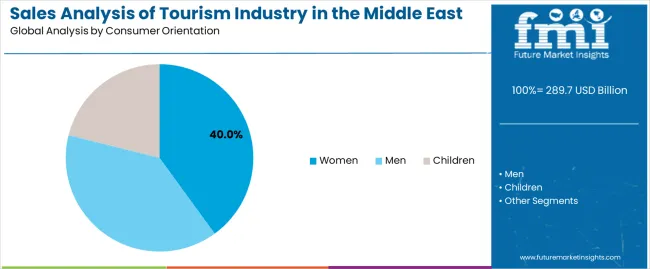
The women consumer orientation segment is expected to account for 40.00% of the tourism market revenue share in the Middle East in 2025, reflecting strong demand from female travelers. This growth is influenced by increasing financial independence, changing societal norms, and a greater focus on lifestyle experiences among women. Travel offerings have been increasingly tailored to meet the preferences of female travelers, including safety, convenience, wellness, and cultural experiences.
Women travelers are also increasingly utilizing digital platforms for researching and booking trips, benefiting from personalized recommendations and curated itineraries. The growing interest in solo travel, group tours, and themed experiences among women has further accelerated demand. Hospitality providers and tourism operators are responding by designing packages, accommodations, and services that align with the specific needs and expectations of women.
The segment’s prominence is reinforced by marketing strategies targeting female audiences and the availability of flexible, women-centric travel experiences This has positioned women as a key driving force in the Middle East tourism market.
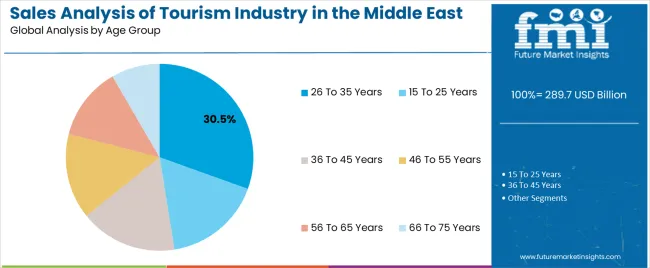
The 26 to 35 years age group is anticipated to hold 30.50% of the tourism market revenue share in the Middle East in 2025, making it the leading age segment. This group is characterized by high digital engagement, disposable income, and a strong preference for experiential and adventure-based travel. Young professionals within this age range are increasingly seeking personalized and memorable travel experiences that combine leisure, culture, and lifestyle activities.
The adoption of online booking, mobile applications, and social media for travel planning is particularly high among this segment, driving demand for convenient, tech-enabled travel services. Marketing strategies aimed at millennials and young adults, along with the proliferation of influencer-driven content and travel reviews, have also influenced their choices and increased bookings.
Additionally, flexible work arrangements and a growing emphasis on work-life balance are encouraging travel among this age group These factors collectively support the dominance of the 26 to 35 years age segment in shaping the growth and development of the Middle East tourism industry.
More Millennials and Gen Zers Make Visits to the Middle East
Millennials and Gen Z are changing travel and tourism. They tend to care more about experiences than things and want authentic trips. They use technology a lot to plan trips and share their experiences online.
They look for unique and meaningful travel experiences that match their values. Because they travel a lot to the Middle East, businesses are changing how they offer services and advertise to meet their needs. It shows that younger people have a big influence on the tourism industry.
Governments Know the Importance of Tourism and Their Policies Highlight it
In the Middle East, governments are focusing on tourism to grow their economies. They are making it easier for tourists to visit the region by changing visa rules and improving entry procedures. Hosting big events and cultural exhibitions helps to show off the region's attractions to people from around the world.
Governments also help tourism by building better roads and facilities, running ads to attract tourists, and making rules that support the industry. All these efforts make it easier for tourism to grow, bringing in more investment and creating jobs for people in different fields. An example is the UAE’s Tourism Strategy 2035. It fortifies UAE’s position as a leading tourism destination. This policy is helping in developing and diversifying tourism products and services.
Infrastructure Development is Happening at Lightning Pace
Countries like the UAE, Qatar, and Saudi Arabia are seeing the building of lots of fancy attractions to entice tourists. With nice hotels and easy transportation, more tourists want to come and have a good time. This helps the tourism industry grow and makes these countries popular destinations for travelers.
The chairman of Abu Dhabi's Department of Culture and Tourism announced plans to invest more than USD 465 billion in infrastructure as part of the emirate's new tourism strategy. To complement the Abu Dhabi Tourism Strategy 2035, the emirate plans to increase the number of hotel rooms to 52,000 from the existing 34,000.
In February 2025, the Emirates Tourism Council released the 'National Tourism Charter', which is an important component of the National Tourism Strategy 2035. The program intends to coordinate national efforts to promote the UAE tourism industry's long-term growth and competitiveness at the global and regional levels.
It will assist in establishing the country as an important contributor in the global travel and tourism environment, as well as encourage collaboration among the seven emirates to improve tourism destinations and products.
| Leading Booking Channel for Tourism in the Middle East | Online Booking |
|---|---|
| Total Value Share (2025) | 36.80% |
Online booking platforms make planning trips to the Middle East easy. With smartphones and an internet connection, travel booking can be done anytime, anywhere. Visitors can choose hotels, flights, and activities that fit their budget and preferences. These platforms also offer good deals and discounts, saving money for travelers. Plus, they confirm bookings instantly, so travelers don't have to wait. If plans change, they can modify or cancel easily without extra fees.
Websites like Expedia, MakeMyTrip, Booking.com, and Airbnb are user-friendly. They also offer customer support that is available 24/7. Travelers feel safe because of secure payment systems and the protection of personal information. Overall, online booking platforms have changed how people travel in the Middle East, making it simpler, more flexible, and more secure.
| Leading Age Group for Tourism in the Middle East | 26 to 35 Years |
|---|---|
| Total Value Share (2025) | 30.50% |
People in this age group mostly have more money to spend because they've finished their schooling and have stable jobs. They may travel for work, weddings, or family vacations. Social media also influences them to travel by showing them cool places and experiences.
Some tourists in this age group are also entrepreneurs looking for inspiration and business connections. Some are also concerned about the environment and choose eco-friendly travel options. They care about sustainability and want to support conservation efforts. Many have flexible jobs, so they can take longer trips or work while traveling. Traveling helps them learn about themselves and other cultures. They can easily find travel information online and plan their trips.
When we think about the Middle East, the Hajj comes to mind first. Muslim followers from all over the world visit Mecca for the Hajj pilgrimage, which is revered as a holy place for Muslims worldwide. Situated in Saudi Arabia, this hotspot significantly adds to the demand for Middle Eastern tourism.
Here are some other tourism hotspots that boost revenues in the Middle East
Petra, Jordan: Petra is an ancient city in southern Jordan, renowned for its stunning architecture and archaeological significance. Highlights of this Middle Eastern tourist place include the Treasury (Al-Khazneh), the Monastery (Ad Deir), and the Siq, a narrow canyon leading to the city's entrance. Jordan’s tourism sector added nearly 14.6% to the GDP in 2025 despite challenges.
Jerusalem, Israel: Jerusalem is a sacred city revered by three monotheistic religions - Judaism, Christianity, and Islam. The country had nearly 289.7 million tourists in 2025. The tourism sector in Israel accounts for 2.8% of the GDP and nearly 3.5% of total employment. In 2025, Israel’s tourism income was USD 5.955 billion.
Cappadocia, Türkiye: Cappadocia is famous for its surreal landscape of fairy chimneys, rock formations, and underground cities. Türkiye’s tourism revenues reached USD 54.32 billion in 2025, marking a 17% increase from 2025’s USD 46.48 billion.
In recent years, however, there has been a recorded uptick in violence across the Middle East. According to press sources, Iraq and Syria are insecure due to incidents of violence and disorder, as well as the influence of some extreme organizations. The rising tension between Israel and Palestine over the Gaza Strip has made the region less safe as well.
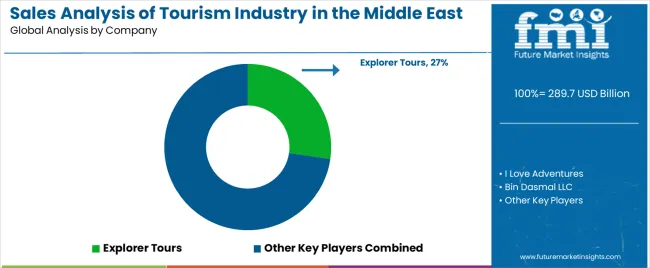
The Middle East tourism industry is intensely competitive, with prominent airlines, hotels, and internet booking platforms fighting for share. Airlines like Emirates, Qatar Airways, and Saudia compete for passengers, while hotel brands like Marriott and Hilton fight for supremacy in key locations like Dubai and Abu Dhabi.
Online travel firms such as Booking.com and Expedia provide another layer of competition by attracting travelers through technology and marketing. Economic considerations, shifting consumer tastes, and geopolitical dynamics shape the environment, necessitating agility and innovation to remain competitive. Differentiation, customer focus, and investment in technology and sustainability are critical tactics for firms looking to flourish in this changing industry.
Recent Developments
| Attribute | Details |
|---|---|
| Estimated Industry Size in 2025 | USD 275.64 billion |
| Projected Industry Size by 2035 | USD 453.28 billion |
| Anticipated CAGR between 2025 to 2035 | 5.10% CAGR |
| Historical Analysis of Demand for Tourism in the Middle East | 2020 to 2025 |
| Demand Forecast for Tourism in the Middle East | 2025 to 2035 |
| Report Coverage | Industry Size, Industry Trends, Analysis of Key Factors influencing Tourism in the Middle East, Insights on Global Players and their Industry Strategy in the Middle East, Ecosystem Analysis of Local and Regional Middle East Manufacturers |
| Key Countries Analyzed While Studying Opportunities in Tourism in the Middle East | Saudi Arabia, Bahrain, Jordan, Oman, Kuwait |
| Key Companies Profiled | Emirates Group; Saudi Arabian Airlines (Saudia); Qatar Airways; Etihad Airways; Jumeirah Group; Marriott International; Hilton Worldwide; AccorHotels; InterContinental Hotels Group (IHG); Emaar Hospitality Group; Dubai Tourism; Abu Dhabi Tourism & Culture Authority; Oman Tourism Development Company (Omran); Jordan Tourism Board; Egypt Tourism Authority; Royal Caribbean Cruises; MSC Cruises; Carnival Corporation; TUI Group;Airbnb |
The global sales analysis of tourism industry in the middle east is estimated to be valued at USD 289.7 billion in 2025.
The market size for the sales analysis of tourism industry in the middle east is projected to reach USD 465.0 billion by 2035.
The sales analysis of tourism industry in the middle east is expected to grow at a 4.8% CAGR between 2025 and 2035.
The key product types in sales analysis of tourism industry in the middle east are online booking, phone booking and in-person booking.
In terms of consumer orientation, women segment to command 40.0% share in the sales analysis of tourism industry in the middle east in 2025.






Our Research Products

The "Full Research Suite" delivers actionable market intel, deep dives on markets or technologies, so clients act faster, cut risk, and unlock growth.

The Leaderboard benchmarks and ranks top vendors, classifying them as Established Leaders, Leading Challengers, or Disruptors & Challengers.

Locates where complements amplify value and substitutes erode it, forecasting net impact by horizon

We deliver granular, decision-grade intel: market sizing, 5-year forecasts, pricing, adoption, usage, revenue, and operational KPIs—plus competitor tracking, regulation, and value chains—across 60 countries broadly.

Spot the shifts before they hit your P&L. We track inflection points, adoption curves, pricing moves, and ecosystem plays to show where demand is heading, why it is changing, and what to do next across high-growth markets and disruptive tech

Real-time reads of user behavior. We track shifting priorities, perceptions of today’s and next-gen services, and provider experience, then pace how fast tech moves from trial to adoption, blending buyer, consumer, and channel inputs with social signals (#WhySwitch, #UX).

Partner with our analyst team to build a custom report designed around your business priorities. From analysing market trends to assessing competitors or crafting bespoke datasets, we tailor insights to your needs.
Supplier Intelligence
Discovery & Profiling
Capacity & Footprint
Performance & Risk
Compliance & Governance
Commercial Readiness
Who Supplies Whom
Scorecards & Shortlists
Playbooks & Docs
Category Intelligence
Definition & Scope
Demand & Use Cases
Cost Drivers
Market Structure
Supply Chain Map
Trade & Policy
Operating Norms
Deliverables
Buyer Intelligence
Account Basics
Spend & Scope
Procurement Model
Vendor Requirements
Terms & Policies
Entry Strategy
Pain Points & Triggers
Outputs
Pricing Analysis
Benchmarks
Trends
Should-Cost
Indexation
Landed Cost
Commercial Terms
Deliverables
Brand Analysis
Positioning & Value Prop
Share & Presence
Customer Evidence
Go-to-Market
Digital & Reputation
Compliance & Trust
KPIs & Gaps
Outputs
Full Research Suite comprises of:
Market outlook & trends analysis
Interviews & case studies
Strategic recommendations
Vendor profiles & capabilities analysis
5-year forecasts
8 regions and 60+ country-level data splits
Market segment data splits
12 months of continuous data updates
DELIVERED AS:
PDF EXCEL ONLINE
Retail Glass Packaging Industry Analysis in Europe and the Middle East and Africa - Size, Share, and Forecast 2025 to 2035
Middle East and Africa (MEA) Tourism Security Market Analysis 2025 to 2035
Market Share Distribution Among Theme Park Tourism Providers
Middle East Wood Flooring Market Growth – Trends & Forecast 2024-2034
Middle East Flooring and Carpet Industry Analysis Size and Share Forecast Outlook 2025 to 2035
Steel Drum Industry Analysis in Southeast Asia Size and Share Forecast Outlook 2025 to 2035
3D Printing Industry Analysis in Middle East Size and Share Forecast Outlook 2025 to 2035
Food Premix Industry Analysis in Middle East - Size and Share Forecast Outlook 2025 to 2035
Asia & MEA PET Bottle Market Trends & Industry Forecast 2024-2034
Industry Analysis of Medical Device Packaging in Southeast Asia Size and Share Forecast Outlook 2025 to 2035
Middle East & Africa Sachet Packaging Machines Market Size and Share Forecast Outlook 2025 to 2035
Middle East & Africa Hydrolyzed Bovine Collagen Market Size and Share Forecast Outlook 2025 to 2035
Middle East and North Africa Frozen Food Market Size and Share Forecast Outlook 2025 to 2035
Middle East and Africa Bio-Stimulants Market Size and Share Forecast Outlook 2025 to 2035
Middle East and Africa Latex Foil Balloons Market Size and Share Forecast Outlook 2025 to 2035
Middle East & Africa Data Storage Market Report – Trends & Industry Forecast 2025–2035
Middle East Veterinary Vaccine Market Analysis - Size, Share, and Forecast 2025 to 2035
Middle East and Africa Rough Terrain Cranes Market Growth - Trends & Forecast 2025 to 2035
Middle East/North Africa (MENA) Commercial Vehicles Market Analysis - Size, Share, and Forecast 2025 to 2035
Middle East Conveyor Belts Market - Growth & Demand 2025 to 2035

Thank you!
You will receive an email from our Business Development Manager. Please be sure to check your SPAM/JUNK folder too.
Chat With
MaRIA